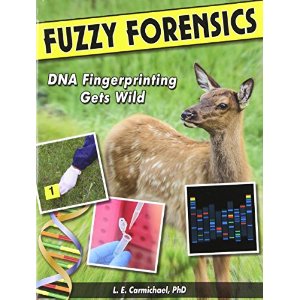| ________________
CM . . .
. Volume 21 Number 20 . . . . January 30, 2015
excerpt:
Forensic scientists work at gathering evidence from crime scenes that will be used to solve mysteries and convict criminals. As important as it is for solving human crimes, this scientific method also has a high profile in the investigation of wildlife issues, such as poaching, illegal transfer of endangered or restricted species, and confirming family relationships within an animal population. This book presents an actual case study involving an elk illegally incorporated into a farmed herd. It explains how DNA fingerprints were used to resolve the mystery and uphold hunting regulations. The author also shows how DNA can substantiate pet breeding claims, identify endangered species and sources of smuggled animal products such as elephant ivory -- all of which aims to help biologists protect and conserve wildlife. The first three chapters detail the case study of an Alberta elk which was taken from the wild to become part of a farmed herd. Since this is considered an illegal form of hunting under the Wildlife Act, it was up to conservation officers to prove conclusively that a law had been broken. The author was personally involved in the examination of DNA to show the origins of the elk. Additional information is included to extend understanding: markers that biologists use to tag various species, why elk are farmed, how the DNA collection and processing is done, and statistics about wildlife crime in Alberta. While the facts are well researched and the stories interesting, the scientific explanation about purifying DNA is quite complex and might challenge the average reader. One’s attention is distracted on these pages by many inserts, fact boxes and diagrams as well as the main text. Four experiments are included in the book. They are intended to help readers understand how populations of wildlife are estimated, how to purify DNA simply from a plant, how to interpret data to determine a pet’s parentage and to track the origins of pet turtles that have been released into the wild populations. With some basic chart-reading and math skills, teen readers should be able to work through the experiments. In particular, the turtle experiment will be especially relevant to young readers with hands-on experience with such pets and will help them understand the damage to wild reptile species from careless releases. Four pages seem targeted more to an adult reader. They focus on the problem of poaching and the business of game ranching specifically in Alberta. Young readers may not be sufficiently motivated to “look for similar programs” if they are interested in learning about these issues elsewhere in the world as well. Quite a number of pages are devoted to bibliographic material, acknowledgments and credits. The Index is not placed at the very end of the book. The content of this book has an unbalanced feel. Three-quarters of it are devoted to the elk case study (since it was used to explain the forensic science approach), and only one chapter discusses other situations in which DNA fingerprinting is an investigative tool. The case study details seemed rather drawn out while more examples or additional information about the other cases would have been welcome. Forensics is a fascinating science and young readers will enjoy learning how it is applied to solving crimes involving wildlife. Recommended.
Gillian Richardson is a freelance writer living in BC.
To comment on this title or this review, send mail to cm@umanitoba.ca.
Copyright © the Manitoba Library Association. Reproduction for personal use is permitted only if this copyright notice is maintained. Any
other reproduction is prohibited without permission.
CM Home |
Next Review |
(Table of Contents for This Issue - January 30, 2015.)
| Back Issues | Search | CM Archive
| Profiles Archive |
